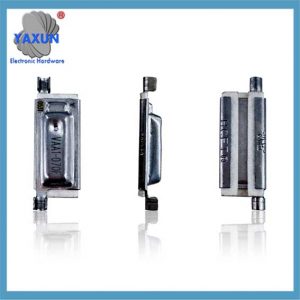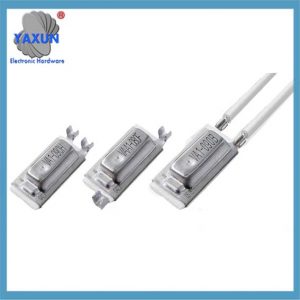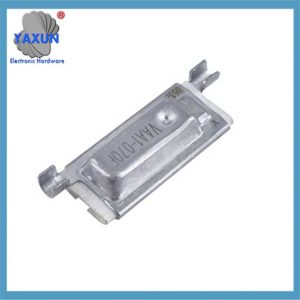Un termostato/protettore termico a scatto con il più alto potere di contatto tra tutti i nostri controlli. Adatto per l'uso su 120/240 Carichi VCA. Disponibile con varietà di elementi bimetallici per migliorare le caratteristiche prestazionali. La scelta dei protettori termici ad azione strisciante richiede un'analisi delle specifiche del palo e del lancio, temperatura impostata, isteresi, corrente nominale massima, tensione CA massima, tensione CC massima nominale, e cambiare vita.
Specifiche del palo e lancio
Singolo palo, tiro singolo (SPST) gli interruttori creano o interrompono la connessione di un singolo conduttore in un singolo circuito derivato. Hanno due terminali e sono comunemente chiamati interruttori “unipolari”..
Singolo palo, doppio lancio (SPDT) gli interruttori creano o interrompono la connessione di un singolo conduttore con uno qualsiasi degli altri due conduttori singoli. Spesso chiamati “interruttori a tre vie”.,I dispositivi SPDT hanno tre terminali e vengono utilizzati in coppia.
Doppio polo, tiro singolo (DPST) gli interruttori creano o interrompono la connessione di due conduttori del circuito in un unico circuito derivato e solitamente hanno quattro terminali.
Doppio polo, doppio lancio (DPDT) gli interruttori creano o interrompono la connessione di due conduttori in due circuiti separati. La maggior parte degli interruttori DPDT hanno sei terminali e sono disponibili nelle versioni con contatto momentaneo o mantenuto.
I protettori termici ad azione strisciante con più di due poli sono progettati per suddividere i carichi in circuiti separati.
Temperatura di set-point dei protettori termici ad azione strisciante
Guida alle specifiche dei protettori termici ad azione strisciante Gli interruttori termici e i protettori termici hanno una temperatura predefinita fissa o regolabile sul campo. Il set point è la temperatura nominale alla quale il dispositivo subisce un cambiamento nello stato associato al movimento dei contatti elettrici. I dispositivi a punto fisso sono classificati a una determinata temperatura mentre i dispositivi adattabili al campo hanno un intervallo di temperatura su cui il set point può essere regolato.
Isteresi dei protettori termici ad azione strisciante
Isteresi, indicato anche come differenziale di temperatura, è un intervallo di temperatura finita su cui avviene la commutazione. È progettato per impedire ai circuiti di cambiare costantemente tra gli stati. Un'isteresi di 0.5 C ti in genere azionario 0.5 gradi oltre la temperatura del set-point e non cambia nuovamente lo stato fino a quando la temperatura scende a 0,5 ° C al di sotto della temperatura set-point.
Temperatura ambiente: La temperatura normale o tipica dell'ambiente che circonda il dispositivo.
Ripristino automatico: Un termostato che si ripristina automaticamente alla configurazione del contatto pre-intervento a una temperatura preimpostata in fabbrica.
Bimetallico: Due metalli con velocità di espansione diverse legati insieme a livello molecolare per formare una lama o un disco per un termostato.
Termostato ad azione strisciante: Un termostato con una lama bimetallica che chiude lentamente i contatti o apre lentamente i contatti.
Declassamento corrente: Termine utilizzato per descrivere una condizione prevedibile in cui l'aumento della corrente applicata a un termostato provoca l'apertura del dispositivo a una temperatura inferiore al punto impostato. Questa condizione è presente solo nei termostati bimetallici normalmente chiusi sensibili sia alla corrente che alla temperatura.
Temperatura di funzionamento: (TF di Tf) In riferimento ad un taglio termico, come definito dalle norme IEC, la temperatura alla quale un interruttore termico apre un circuito in assenza di carico. La tolleranza IEC è +0 C, -10 C.
Mantenimento della temperatura: (TH o Th) In riferimento ad un taglio termico, la temperatura massima alla quale un interruttore termico può mantenere la corrente nominale per un periodo di 168 ore di funzionamento.
Temperatura massima: (TM o TM) In riferimento ad un taglio termico, la temperatura massima alla quale il dispositivo può essere sottoposto per un periodo di dieci minuti senza ripristinare la conducibilità una volta aperto.
Differenziale minimo: (noto anche come banda morta) Il numero minimo di gradi tra la temperatura effettiva di apertura e quella di chiusura effettiva.
Protettore del motore: Protettore termico sensibile sia agli aumenti di corrente che agli aumenti di temperatura.
Normalmente chiuso (NC): I contatti si aprono all'aumento della temperatura.
Normalmente aperto (NO.): I contatti si chiudono all'aumentare della temperatura.
Un colpo: Un dispositivo che, una volta attivato alla temperatura preimpostata, non può essere ripristinato. Disponibile solo nella configurazione con contatto Normalmente Chiuso.
Corrente nominale: La corrente massima consentita che un dispositivo può trasportare.
Tensione nominale: La tensione massima che dovrebbe essere applicata a un dispositivo.
Protettore di auto-mantenimento: Un dispositivo che, all'apertura, non si ripristinerà finché non verrà rimossa l'alimentazione dal suo circuito, indipendentemente dalla temperatura ambiente. Disponibile solo nella configurazione con contatto Normalmente Chiuso.
Termostato ad azione rapida: Termostato con elemento Bimetallico che scatta chiudendo i contatti quando si verifica la condizione di attivazione. Questa costruzione consente la rottura netta dei carichi.
Interruzione termica: Un interruttore termico è un dispositivo di sicurezza elettrica che interrompe la corrente elettrica quando riscaldato a una temperatura specifica.
Fusibile termico: Un dispositivo che fonde il suo elemento interno per aprire un circuito in una condizione di sovratemperatura. Noto anche come fusibile termico, fusibile di protezione termica o interruttore termico.
Protettore termico: Un protettore termico è un dispositivo di protezione integrato in un motore che fornisce protezione da sovracorrente o sovratemperatura che scollega l'alimentazione al reattore se la temperatura interna supera il punto di intervento. Ciò protegge i motori dal surriscaldamento. I tipi di interruttori includono il riposo automatico, riarmo manuale e rilevatori di temperatura a resistenza.
Tolleranza: L'intervallo consentito al di sopra e al di sotto della temperatura nominale.
 English
English Afrikaans
Afrikaans العربية
العربية বাংলা
বাংলা bosanski jezik
bosanski jezik Български
Български Català
Català 粤语
粤语 中文(简体)
中文(简体) 中文(漢字)
中文(漢字) Hrvatski
Hrvatski Čeština
Čeština Nederlands
Nederlands Eesti keel
Eesti keel Suomi
Suomi Français
Français Deutsch
Deutsch Ελληνικά
Ελληνικά हिन्दी; हिंदी
हिन्दी; हिंदी Magyar
Magyar Bahasa Indonesia
Bahasa Indonesia Italiano
Italiano 日本語
日本語 한국어
한국어 Latviešu valoda
Latviešu valoda Lietuvių kalba
Lietuvių kalba македонски јазик
македонски јазик Bahasa Melayu
Bahasa Melayu Norsk
Norsk پارسی
پارسی Polski
Polski Português
Português Română
Română Русский
Русский Cрпски језик
Cрпски језик Slovenčina
Slovenčina Slovenščina
Slovenščina Español
Español Svenska
Svenska ภาษาไทย
ภาษาไทย Türkçe
Türkçe Українська
Українська اردو
اردو Tiếng Việt
Tiếng Việt



